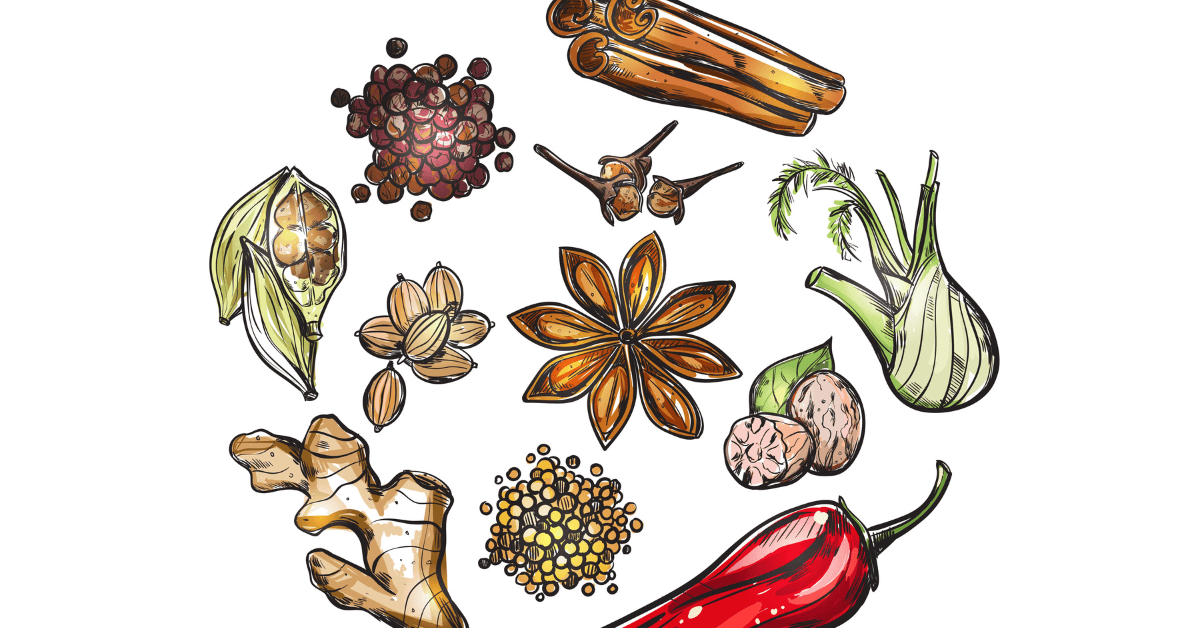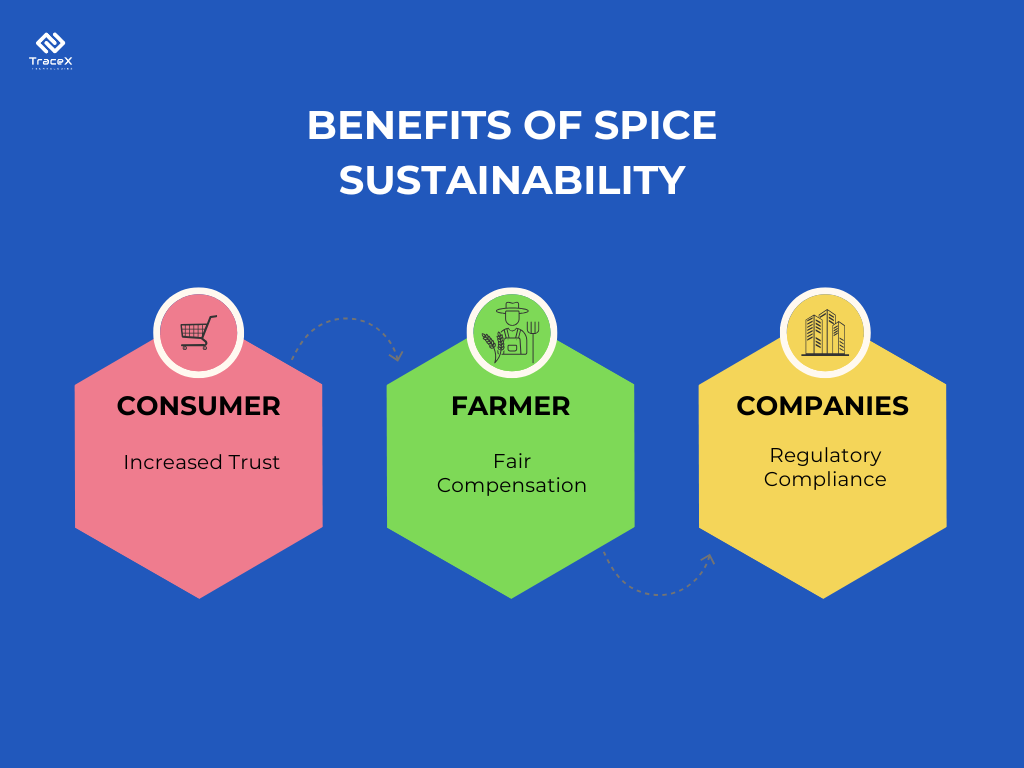Contact: +91 99725 24322 |
Menu
Menu
Quick summary: Explore how technology is revolutionizing sustainable spice sourcing, enhancing transparency, efficiency, and accountability in the industry. Discover the benefits of blockchain, data analytics, and innovative practices for a sustainable future.

In a world increasingly focused on sustainability, the spice industry faces unique challenges. From vanilla in Madagascar to turmeric in India, the journey of spices is often marred by complex supply chains, environmental strain, and economic disparities. Do you know sustainable spice sourcing matters and it can create a lasting impact on communities and ecosystems worldwide.
According to ICAR, in India, approximately 63 spice varieties are grown in a variety of agro-climatic conditions. While the demand for spice exports continues to thrive, there is a growing awareness and concern regarding food safety worldwide. This heightened awareness underscores the necessity for primary spice producers to deliver products that adhere to the rigorous standards and quality requirements established by importing nations.
Traditional sourcing practices can lead to soil degradation, unfair wages for smallholder farmers, and a lack of transparency that leaves consumers in the dark about the true origin of their products. As demand for ethically sourced and environmentally friendly spices grows, sustainable practices are no longer just a value-add; they’re a necessity. Embracing sustainability in spice sourcing isn’t just about environmental responsibility—it’s about building resilient supply chains that support both people and the planet.
Key Takeaways
Sustainable spice sourcing refers to the practice of procuring spices in a manner that is environmentally friendly, socially responsible, and economically viable. Here are some key aspects of sustainable spice sourcing:
Spice sourcing might seem simple, but it’s a complex process with a lot of hidden challenges. Imagine the journey of a single cinnamon stick from a farm in Sri Lanka to a kitchen shelf in Europe. Behind this journey are layers of issues that can make it tough for companies to ensure that their spices are sourced responsibly and sustainably.
In traditional spice sourcing, these challenges often go unaddressed, as the focus is primarily on getting products to market quickly and cheaply. But as consumers become more aware, the demand for sustainable practices in spice sourcing is on the rise, pushing companies to find better ways to source their spices responsibly.
Certifications play a vital role in promoting sustainability within the spice industry, ensuring that products are sourced and produced in an environmentally responsible and socially equitable manner. With various standards available, including UEBT (Union for Ethical BioTrade), Fair Trade, USDA Organic, Rainforest Alliance, and others, these certifications help stakeholders navigate the complexities of sustainable sourcing.
A leading spice processor based in Karnataka, India, recognized for its dedication to quality and sustainability, has implemented the TraceX Sustainability platform to enhance the authenticity and safety of its products. With operations extending to Vietnam and Turkey, the company utilizes this advanced technology to ensure traceability and uphold high standards in its supply chain management, reinforcing its commitment to sustainable practices in the spice industry.
In recent years, technology has emerged as a game-changer in addressing the sustainability challenges faced by the spice industry. As consumers become more conscious about where their food comes from and how it’s produced, the need for transparency and responsibility in spice sourcing has never been more critical. Let’s explore how various technologies are transforming spice sourcing, making it more sustainable and efficient.
Blockchain is like a digital ledger that records transactions in a secure and transparent way. In spice sourcing, it allows for traceability from farm to table. This means consumers can see exactly where their spices came from, how they were grown, and whether they meet sustainability standards. For farmers, this technology ensures they receive fair compensation by providing proof of the quality and authenticity of their products. It helps build trust between producers, suppliers, and consumers, fostering a more sustainable supply chain.
The Internet of Things involves connecting devices to the internet, allowing them to send and receive data. In spice farming, IoT devices can monitor conditions like soil moisture, temperature, and humidity. This data helps farmers make informed decisions about irrigation and pest control, reducing the use of water and chemicals. By optimizing resource use, farmers can produce spices more sustainably and efficiently.
Data analytics involves collecting and analyzing information to make better decisions. In spice sourcing, companies can use data analytics to track market trends, consumer preferences, and environmental impacts. For instance, by understanding which spices are in high demand and how they are sourced, businesses can adjust their practices to meet sustainability goals. Analytics can also help identify areas where waste can be reduced, leading to more efficient production and distribution processes.
Mobile technology has transformed communication and access to information. For spice farmers, mobile apps can provide valuable resources such as weather forecasts, market prices, and best farming practices. These tools empower farmers to make timely decisions that enhance their yields and ensure sustainability. Additionally, mobile platforms enable better communication between farmers, suppliers, and consumers, creating a more connected and transparent spice supply chain.
Blockchain technology has emerged as a powerful tool for enhancing traceability and transparency in the food supply chain, particularly in the spice industry. By enabling secure and tamper-proof tracking of products from farm to market, blockchain helps address some of the key challenges faced by stakeholders at every level. Let’s explore how this technology works and the benefits it offers to consumers, farmers, and companies, particularly in the context of the TraceX food traceability platform powered by blockchain.
In the spice supply chain, blockchain can be used to track every step of the process—from cultivation and harvesting to processing, packaging, and distribution. Each time a product moves from one stage to another, a new entry is made in the blockchain. This creates a comprehensive, real-time record of the product’s journey.

The TraceX Food Traceability Platform is an advanced digital solution that brings transparency, safety, and accountability to food supply chains. Utilizing blockchain technology, the platform enables agribusinesses to trace every step of the production process, from farm to fork. This secure, tamper-proof system records critical data points at each stage, allowing stakeholders to track the origin, quality, and journey of food products in real-time. With features for managing compliance, ensuring food safety, and enhancing visibility, TraceX’s platform not only builds consumer trust but also supports businesses in meeting regulatory standards and sustainability goals in a streamlined and efficient way.
The integration of technology in sustainable spice sourcing is transforming the industry by enhancing transparency, efficiency, and accountability. From blockchain traceability ensuring product authenticity to data analytics optimizing supply chain operations, these advancements empower farmers, improve sustainability practices, and meet growing consumer demands for ethically sourced products. As the spice industry continues to evolve, embracing these technological innovations will be essential for fostering a more sustainable future that benefits all stakeholders.
Blockchain technology enhances spice sourcing by providing a transparent and immutable ledger of transactions. This allows all stakeholders to track the origin and journey of spice products, ensuring authenticity and building trust among consumers and suppliers.
Data analytics helps spice companies optimize their supply chain operations by analyzing trends, forecasting demand, and managing resources more efficiently. This leads to reduced waste, improved quality control, and better decision-making, ultimately supporting sustainable practices.
Technology empowers smallholder farmers by providing them access to market information, training on sustainable practices, and platforms for direct sales. By leveraging technology, they can enhance productivity, improve their livelihoods, and contribute to a more sustainable spice supply chain.
